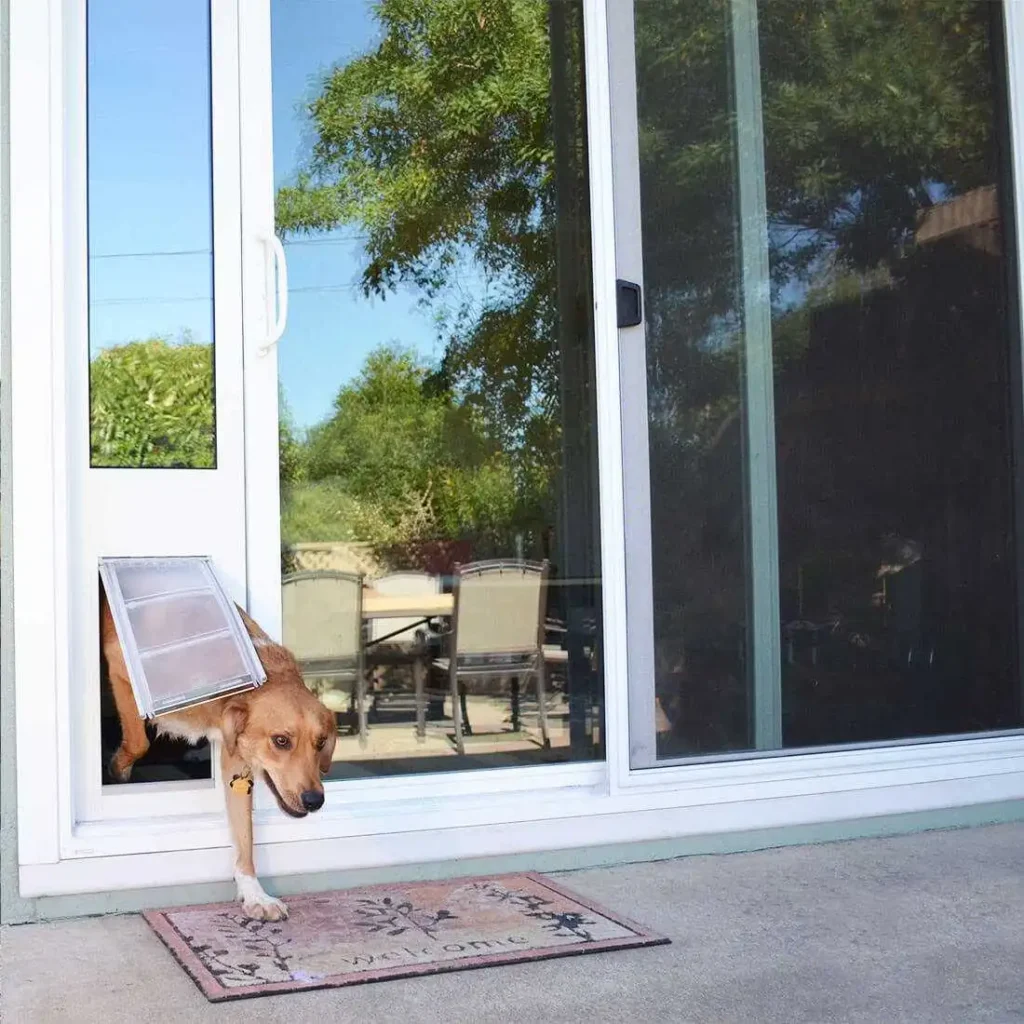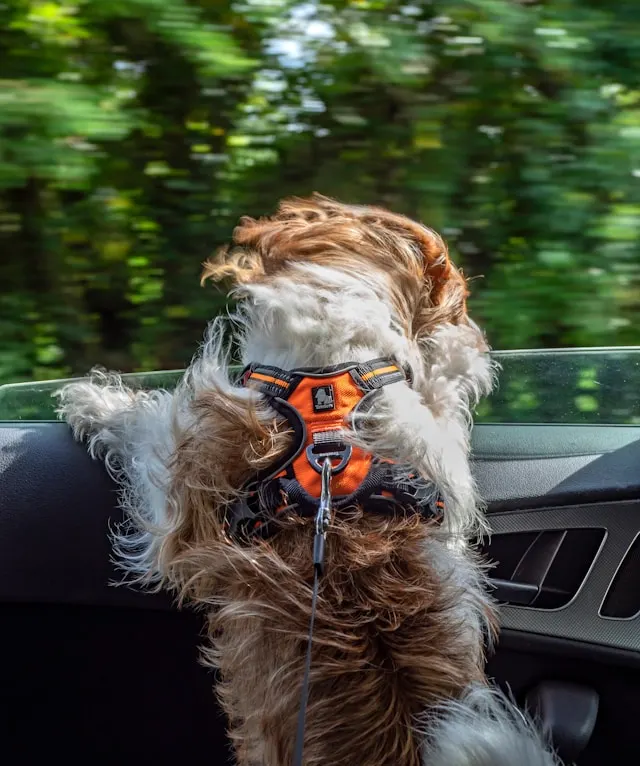Watching your dog pace back and forth at the sliding glass door again? That familiar nose print on the glass and those pleading eyes are clear signs it’s time for a solution. A dog door for sliding glass door installation could be the game-changer your daily routine needs, giving your furry friend the independence they crave.

Table of Contents
Quick Answer
A dog door for sliding glass door is a panel insert that fits into your existing door track, creating a pet entrance without permanent modifications to your home. These panels typically include a flap door sized for your dog and adjust to your door’s height, allowing your pet freedom while maintaining your home’s security and energy efficiency.
TL;DR: Sliding glass dog doors give pets independence without damaging your door frame. They’re removable, secure, and come in various sizes to match your dog’s needs. Best for renters/busy owners; use only with a secure, fenced yard.
Why It Matters
Without proper outdoor access, dogs can develop several health and behavioral issues. Holding urine for extended periods increases the risk of bladder infections and kidney problems. The frustration of waiting for bathroom breaks often leads to anxiety-related behaviors like destructive chewing, excessive barking, or accidents inside.
For working pet parents, a dog door means your furry friend won’t be uncomfortable while waiting for you to return home. Senior dogs and puppies with less bladder control especially benefit from the ability to relieve themselves when needed.
Beyond physical health, having freedom to go outside improves your dog’s mental wellbeing. Dogs naturally enjoy fresh air, sunlight, and the stimulation of watching neighborhood activities. This environmental enrichment helps prevent boredom and depression. If your dog’s licking/whining at the door is anxiety-driven, see our guide to calming products for dogs.
Anatomy of a Sliding Glass Dog Door
Sliding glass dog doors are ingeniously simple yet effective solutions. They consist of an aluminum or vinyl panel that fits directly into your existing door track. This panel replaces part of your sliding door’s range of motion but preserves most of its functionality.
The panel includes a framed opening with a flexible vinyl or thermoplastic flap sized appropriately for your pet. These flaps typically feature magnetic edges to create a weather-tight seal when closed. More premium models feature double-flap systems for better insulation in extreme climates.
The beauty of this design lies in its non-permanent installation. Unlike traditional dog doors that require cutting into a solid door or wall, sliding door inserts can be installed and removed without tools or permanent modifications to your home. This makes them perfect for renters or homeowners who might want to remove the door seasonally.
Height adjustment is another key feature. Most panels come with extension pieces that allow you to achieve a perfect fit from floor to top track, regardless of your door’s height. The panel locks into place using the existing door lock or an additional lock mechanism for security.
Measure This First Checklist
Before shopping for a sliding glass dog door, gather these critical measurements:
- Track-to-track height: Measure from inside the bottom track to inside the top track (not just glass height)
- Available width: Measure how much of your sliding door opening you can sacrifice (typically 10-15 inches)
- Dog’s measurements:
- Shoulder height (floor to top of shoulders)
- Width at widest point (usually shoulders or hips)
- Step-over height comfort (how high your dog can comfortably lift legs)
- Latch location: Note whether your door lock is at standard height or custom positioned
- Track depth: Measure how deep your door track is to ensure compatible panel thickness
Tools & Product Recommendations
We may earn a commission when you buy through our links at no extra cost to you.
PetSafe Freedom Aluminum Patio Panel
Perfect for medium to large dog households, this adjustable aluminum panel slides right into your track system. The vinyl flap features a magnetic closure that helps maintain your home’s energy efficiency.
Specifications:
- Height Range: Adjusts from 75″ to 81″ (track-to-track)
- Flap Size: 10.5″W x 15″H with 5″ step-over height
- Frame Material: Heavy-duty aluminum
- Insulation: Single-flap with magnetic seal
- Lock Type: Slide-in security panel
- Warranty: 1-year limited
Verify your door’s exact track-to-track height against the manufacturer’s current spec sheet before purchase.
What sets this model apart is its heavy-duty aluminum frame construction that stands up to even the most enthusiastic door users. The one limitation is that some dogs may need training to push through the flap initially.
Ideal Pet Products VPP Vinyl Patio Door
Ideal for small to medium-sized breeds, this vinyl panel insert offers a more budget-friendly option without sacrificing quality. The lightweight thermoplastic flap makes it easier for smaller dogs to push through.
Specifications:
- Height Range: Adjusts from 77″ to 80″ (track-to-track)
- Flap Size: 7″W x 11.25″H with 3″ step-over height
- Frame Material: Rigid vinyl
- Insulation: Single-flap with moderate weatherproofing
- Lock Type: Slide-down security panel
- Warranty: 90-day limited
Verify your door’s exact track-to-track height against the manufacturer’s current spec sheet before purchase.
The flexible weatherstripping creates a good seal against drafts. Its main limitation is that the vinyl frame construction isn’t as chew-resistant for determined dogs who might test boundaries.
Endura Flap Double Flap Pet Door
This premium option is the gold standard for homes in extreme climates. With its double-flap design and superior insulation properties, it’s perfect for very hot or cold regions where energy efficiency is crucial.
Specifications:
- Height Range: Varies by model, typically 74.75″ to 96″ (widest range available)
- Flap Size: Multiple options from 6″W x 11″H up to 12″W x 23″H
- Frame Material: Heavy-duty aluminum
- Insulation: Double-flap system with magnetic seal and air barrier
- Lock Type: Reinforced security panel with lock
- Warranty: 15-year limited (best in industry)
Verify your door’s exact track-to-track height against the manufacturer’s current spec sheet before purchase.
The Endura Flap’s unique design withstands winds up to 50 mph without blowing open. The higher price point is its only real drawback, though pet owners in harsh climates report it pays for itself in energy savings.
Ideal Pet “Fast Fit” Aluminum Patio Panel
A versatile, budget-friendly option that works well for a range of dog sizes with multiple flap size options available.
Specifications:
- Height Range: Typically 77″ to 80.5″ (track-to-track)
- Flap Size: S/M/L options (e.g., 6.25″W x 8.25″H up to 10.5″W x 15″H)
- Frame Material: Aluminum
- Insulation: Single flap with magnetic seal
- Lock Type: Slide-in security panel + latch adapter
- Warranty: 1-year limited
- Best for: Budget-friendly aluminum panel; mild–moderate climates
- Limitation: Not as draft-tight as double-flap/low-E glass panels
Verify your door’s exact track-to-track height against the manufacturer’s current spec sheet before purchase.
This affordable aluminum panel provides a solid entry-level option for most climates, with multiple flap sizes to accommodate different breeds. The lightweight design makes for easy installation and removal.
Climate Compatibility Matrix
| Climate Type | Recommended Flap System | Additional Features |
|---|---|---|
| Mild/Moderate | Single flap with magnetic seal | Standard weatherstripping |
| Hot Summers | Single or double flap with UV-resistant material | Reflective film option |
| Cold Winters | Double flap + air barrier; preferred glass: dual-pane/low-E when available; add extra weatherstripping | |
| Extreme Weather | Double flap with reinforced magnets | Draft blockers, foam insulation |
| High Wind Areas | Heavy-duty flap with strong magnets | Wind-resistant design (like Endura) |
Step-by-Step Installation Tutorial
- Measure your sliding door track – Measure the height from the bottom of the track to the top of the track (not just the glass). For width, measure the opening you want to create for the panel.
- Select the right size panel – Choose a panel that adjusts to your measured height and provides an appropriate flap size for your dog (see sizing guide below).
- Prepare the door track – Clean the track thoroughly to remove dirt and debris that could prevent proper installation.
- Install weather stripping – Apply the included weather stripping to the panel edges where it will contact your existing door and frame.
- Insert the panel into the track – Place the bottom of the panel into the lower track, then straighten it to fit into the upper track.
- Adjust the height – Follow the manufacturer’s instructions to extend or adjust the panel to fit snugly from top to bottom.
- Secure the panel – Most panels include a locking method to prevent removal from the outside. Install according to instructions.
- Install additional security – Add a charley bar or security pole in the remaining track, and consider an anti-lift block at the top of the door.
- Test the sliding door – Ensure your original glass door still slides properly and creates a good seal when closed against the panel.
- Train your dog – Introduce your pet to the new door using treats and encouragement. Hold the flap open initially until they understand how it works.
Security Sidebar: Preventing Break-Ins
While dog door panels themselves are secure, the remaining sliding door track presents a potential security vulnerability. Address this with:
Charley Bar Installation: Place a metal or wooden dowel cut to size in the track behind your sliding door. This prevents the door from being forced open even if the lock is compromised.
Anti-Lift Blocks: Install small blocks in the upper track that prevent would-be intruders from lifting your sliding door out of its track—a common break-in method. According to the U.S. Department of Energy, proper weatherstripping not only improves security but can reduce energy costs by up to 20% by preventing drafts around doors.
Motion-Sensing Lights: Install outdoor lighting near your dog door area to discourage nighttime tampering.
Security Panel Use: Always engage the security panel lock when you’re away for extended periods or at night if your dog doesn’t need access.
Flap Types: Material Comparison
Vinyl/Thermoplastic Flaps
- Pros: Lightweight, easy for small or elderly dogs to push, relatively quiet, inexpensive
- Cons: Less durable, may warp in extreme temperatures, less energy efficient
Rigid Plastic Flaps
- Pros: More durable than vinyl, better temperature resistance, moderate weight
- Cons: Can crack over time, moderately priced, may be too heavy for very small dogs
Double-Flap Systems
- Pros: Superior insulation, excellent for extreme climates, better noise reduction
- Cons: Higher cost, may be challenging for small dogs, requires more maintenance
Energy Efficiency Tip: Conduct a simple draft test after installation by holding a lit candle near the edges of your dog door (when closed). Flickering indicates air leakage points that need additional weatherstripping. In windy zones, upgrade magnet strength or choose Endura-style reinforced magnets.
Breed & Weight Sizing Guide
When selecting the right flap size, consider both the height AND width needs of your dog:
- Small (up to 15 lbs):
- Flap size: 5-7″W x 8-11″H
- Step-over height: 3″ maximum
- Breeds: Chihuahuas, Yorkies, Maltese, Shih Tzus, most puppies
- Medium (15-40 lbs):
- Flap size: 8-9″W x 12-15″H
- Step-over height: 3-5″
- Breeds: Beagles, Corgis, Cocker Spaniels, Whippets, small Bulldogs
- Large (40-100 lbs):
- Flap size: 10-12″W x 16-19″H
- Step-over height: 5-7″
- Breeds: Labrador Retrievers, German Shepherds, Boxers, Pit Bulls, Collies
- Extra Large (100+ lbs):
- Flap size: 12-15″W x 20-24″H
- Step-over height: 7-9″
- Breeds: Great Danes, Mastiffs, Newfoundlands, Saint Bernards
Step-Over Height Guidance: The ideal step-over height should be no more than 1/3 of your dog’s shoulder height. Senior dogs, puppies, and breeds with short legs (like Dachshunds or Basset Hounds) need even lower step-over heights—aim for 25% of shoulder height maximum.
Common Mistakes (and Fixes)
Incorrect height measurement. The fix: Measure from track to track, not glass to glass, and account for any height adjusters on your door system.
Choosing too small a flap size. The fix: Select a flap at least 1-2 inches taller than your dog’s shoulder height and wide enough for their broadest point for comfortable passage.
Ignoring step-over height. The fix: For elderly dogs or breeds with short legs, choose models with lower-rise/accessible pet doors.
Poor weather sealing. The fix: Apply additional weatherstripping where gaps appear, and consider upgrading to a double-flap system in harsh climates.
Not securing the remaining track. The fix: Install a charley bar or dowel in the track to prevent forced entry through the remaining sliding door opening.
Skipping the training phase. The fix: Take time to properly introduce your dog to the door using positive reinforcement and patience.
Installing in a high-traffic area. The fix: If possible, choose a sliding door that’s not your main entrance/exit to reduce interference.
Troubleshooting (If/Then)
If the panel seems loose in the track, then add additional weather stripping to create a more secure fit.
If your dog is afraid of the flap, then tape it open temporarily until they get used to the opening, gradually lowering it over several days.
If the door is drafty in winter, then add a second layer of weatherstripping or upgrade to a double-flap energy-efficient model.
If the flap isn’t closing properly, then check for debris in the hinge area and clean thoroughly.
If your sliding door won’t lock against the panel, then verify the panel width and consider a model with a built-in lock system.
If the step-over is too high for your dog, then look for adjustable step-over models or place a small non-slip ramp on both sides.
If the flap is too heavy for your small dog, then look for tension-adjustable models or switch to a lighter vinyl flap option.
When to See a Professional
While most sliding glass dog doors are designed for DIY installation, certain situations call for professional help:
- Your sliding door has an unusual track system or non-standard dimensions
- You’re uncomfortable working with tools or making measurements
- Your door is very old or the tracks are damaged
- You want a permanent, in-glass dog door installation rather than a panel
- Your homeowners association has specific requirements for exterior modifications
- You notice damage to your door frame that needs repair before installation
FAQs
Will a sliding glass dog door affect my home’s energy efficiency?
Most quality dog doors have weatherstripping and insulated flaps that minimize energy loss. Premium models with double flaps provide excellent insulation comparable to your sliding door itself.
Can I install a dog door if I’m renting?
Yes! Sliding glass dog doors are ideal for renters since they don’t require permanent modifications. Just remove the panel when you move out.
How do I prevent other animals from entering through my dog door?
Choose a door with electronic activation that only opens when triggered by a collar sensor. Alternatively, use the locking cover when you’re away or at night.
Are sliding glass dog doors secure?
Most include security panels that lock in place when not in use. For additional security, install a charley bar in the track and anti-lift blocks at the top of your sliding door.
How much width will I lose from my doorway?
Typically 10-15 inches depending on the model and flap size. Measure your current doorway to ensure you’ll still have comfortable human passage and measure your remaining human passage width to avoid surprises.
How difficult is installation?
Most homeowners complete installation in 30-60 minutes with basic measuring skills. No special tools are required for standard installations.
Does my dog need training to use the door?
Most dogs learn quickly with positive reinforcement. American Veterinary Medical Association recommends consistent training sessions and patience when introducing pets to new equipment.
Conclusion
A dog door for sliding glass door installation offers the perfect balance of convenience, affordability, and non-permanent modification that works for most homes and lifestyles. By giving your furry friend the freedom to go outside when nature calls, you’re reducing the risk of accidents, bladder issues, and anxiety-related behaviors.
The installation process is straightforward enough for most homeowners to handle as a weekend project. With proper measurement and selection of appropriate flap size and step-over height, your new dog door will provide years of convenience for both you and your pet.
Consider your dog’s size, your climate, and security needs when making your selection. And remember, a small investment now in a quality dog door saves countless interruptions to your day and significantly improves your dog’s quality of life. Your dog will thank you with fewer accidents, less whining at the door, and the joy that comes with a bit more canine independence.

